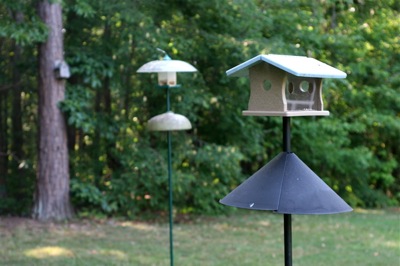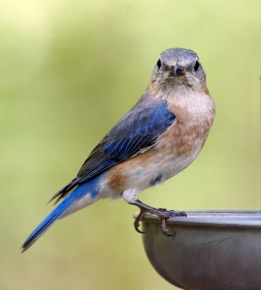- Bird Accessories, Bird Feeders, Bluebird Feeders, Fruit, Jelly & Mealworm Feeders, Live Meal Worms, Mealworm Feeder, Uncategorized
nasty yellow jackets at the mealworm feeder
Lots of bluebirds have passed through this mealworm feeder in our back yard. Last season we had three successful broods of Eastern Bluebirds, in part, thanks to a welcoming habitat. Even the Chickadees, Carolina Wrens and Titmice have learned to use this fly-in mealworm feeder with ease… which I’m not sure is such a good thing? Worms are really reserved for our bluebirds only! This traditional type bluebird feeder is made from recycled plastic, and although it’s about five years old now, it still looks and acts the same way as when it was first installed. With so much junk out there, who doesn’t like quality stuff!
What I am sure of that’s not a good thing are the yellow jackets who continue to torture the live worms inside the feeder! When, for heaven’s sake is it time for them to die off? Every morning when I go to add worms for the patiently waiting, eager bluebirds… the yellow jackets are in there munching on worm remains.
Last night it was in the 20’s here in North Georgia, and finally this morning none of the nasty jax were seen! The weather here is crazy though, hot, cold, warm cold, even some bulbs started forcing their way through the ground with the last dip in temperatures.
I can only hope with this last frost, that all yellow jackets are gone for the season! I think the birds will be happy too 🙂
-
you put what in the mealworm feeder?
We feed lots of mealworms for our Bluebirds, and Titmice, and Nuthatches, and Carolina Wrens, even the Cardinals learned to get in on the game. Because we use several mealworm feeder dishes, and only one enclosed bluebird feeder, it’s pretty much a free-for-all. Buying the worms in bulk greatly reduces the cost of feeding so many worms, and I can honestly say they are a favorite of many birds.
It’s so hot and humid, I think my brain may have started to melt today. In the morning, there’s a ritual of starting the day and feeding the pets and the birds. Because fledgelings abound this time of year, we dust the mealworms with calcium carbonate as they are “calcium-depleting” and young birds need strong bones.
Today the calcium carbonate almost went in the coffee, while the creamer was headed for the worms! I don’t think the birds would have appreciated coffee mate, and I know the coffee would have been pretty gross. Luckily I caught myself and thought “what the heck?” All was good with the world, or so I thought.
Later that afternoon I arrived at FedEx to drop off several packages. Only to find the back of the car empty and the boxes still home by the garage door 🙁 Yes, I believe the heat is actually melting my brain, I’m hoping it doesn’t self-combust! Tomorrow, maybe I’ll start the day under one of the leaf misters for some cooling off.
-
Keep that mealworm feeder filled
For all the moms out there raising babies on their own… Happy Mothers Day!
A Gilbertson nest box was their preference, and soon 5 Bluebird eggs sat in the nest. A pair of Eastern Bluebirds who braved a harsh winter in North Georgia found their perfect nest site. It wasn’t long at all before the eggs hatched and five babies slept comfortably in the pine straw nest. I’m not sure when the eggs were laid, but the next time the box was checked it contained the cutest naked babies.
Then some trouble for our Bluebird pair 🙁 Nothing had gotten into the box or killed the babies, it’s dad who had disappeared. With babies fully feathered now and overflowing their nest, dad had been missing for two days, at this crucial fledge time too.
The next box check revealed that mom had managed to fledge all five babies, so this gave me hope for at least a partially successfully brood. I supplemented the the worms with calcium carbonate powder to help build strong bones, and doubled the number of worms being offered in the mealworm feeder.
When raising bluebirds, both parents will feed the chicks for thirty days. Even second or third broods receive help from older siblings. Super mom was on her own, and the nasty storms during their first few nights out in the world didn’t help at all. I was like the worrisome mother. Sometimes another mate is found and the new male may or may not help to care for her brood. About two weeks after fledging, a new male was spotted gorging himself at the mealworm feeder. My only hope was that some of the worms were for the babies.
Two days ago I spotted one of the babies perched on the pole above the mealworm feeder… yellow mouth wide open and screaming his little head off! It was truly a terrific site and gave me hope that more of the five are thriving.
So, in honor of Mother’s Day… here’s to you Mrs. Bluebird! Raising babies on your own out in a tough and cold world, we wish you the best.





